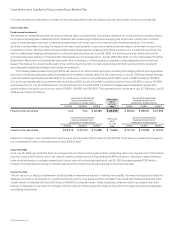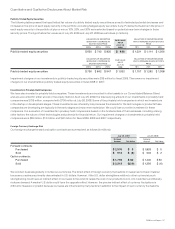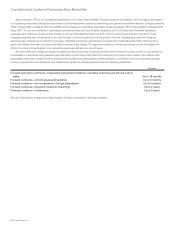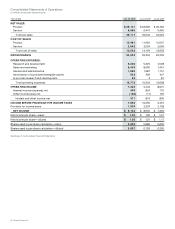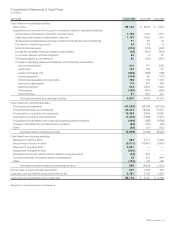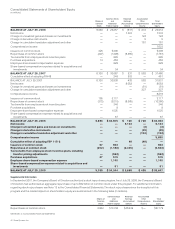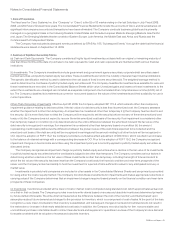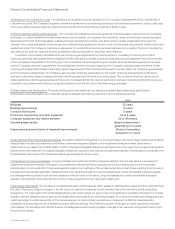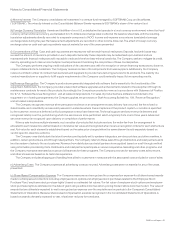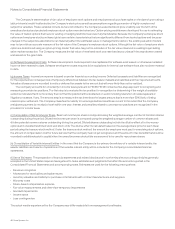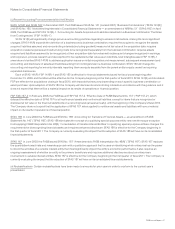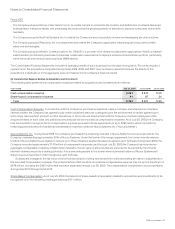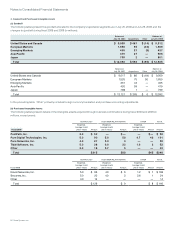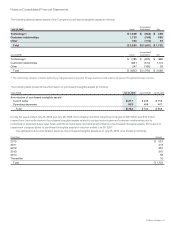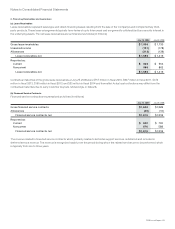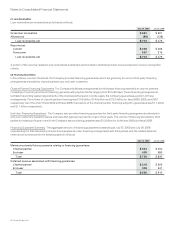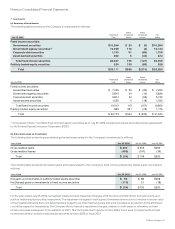Cisco 2009 Annual Report Download - page 48
Download and view the complete annual report
Please find page 48 of the 2009 Cisco annual report below. You can navigate through the pages in the report by either clicking on the pages listed below, or by using the keyword search tool below to find specific information within the annual report.
Notes to Consolidated Financial Statements
The Company’s determination of fair value of employee stock options and employee stock purchase rights on the date of grant using a
lattice-binomial model is affected by the Company’s stock price as well as assumptions regarding a number of highly complex and
subjective variables. These variables include, but are not limited to, the Company’s expected stock price volatility over the term of the
awards and actual and projected employee stock option exercise behaviors. Option-pricing models were developed for use in estimating
the value of traded options that have no vesting or hedging restrictions and are fully transferable. Because the Company’s employee stock
options and employee stock purchase rights have certain characteristics that are significantly different from traded options and because
changes in the subjective assumptions can materially affect the estimated value, in management’s opinion, the existing valuation models
may not provide an accurate measure of the fair value of the Company’s employee stock options. Although the fair value of employee stock
options is determined using an option-pricing model, that value may not be indicative of the fair value observed in a willing buyer/willing
seller market transaction. The Company measures the fair value of restricted stock and restricted stock units as if the awards were vested
and issued on the grant date.
(p) Software Development Costs Software development costs required to be capitalized for software sold, leased, or otherwise marketed
have not been material to date. Software development costs required to be capitalized for internal use software have also not been material
to date.
(q) Income Taxes Income tax expense is based on pretax financial accounting income. Deferred tax assets and liabilities are recognized
for the expected tax consequences of temporary differences between the tax bases of assets and liabilities and their reported amounts.
Valuation allowances are recorded to reduce deferred tax assets to the amount that will more likely than not be realized.
The Company accounts for uncertainty in income taxes pursuant to FIN 48. FIN 48 contains a two-step approach to recognizing and
measuring uncertain tax positions. The first step is to evaluate the tax position for recognition by determining if the weight of available
evidence indicates that it is more likely than not that the position will be sustained on audit, including resolution of related appeals or
litigation processes, if any. The second step is to measure the tax benefit as the largest amount that is more than 50% likely of being
realized upon settlement. The Company classifies the liability for unrecognized tax benefits as current to the extent that the Company
anticipates payment (or receipt) of cash within one year. Interest and penalties related to uncertain tax positions are recognized in the
provision for income taxes.
(r) Computation of Net Income per Share Basic net income per share is computed using the weighted-average number of common shares
outstanding during the period. Diluted net income per share is computed using the weighted-average number of common shares and
dilutive potential common shares outstanding during the period. Diluted shares outstanding include the dilutive effect of in-the-money
options and unvested restricted stock and stock units. The dilutive effect is calculated based on the average share price for each fiscal
period using the treasury stock method. Under the treasury stock method, the amount the employee must pay for exercising stock options,
the amount of compensation cost for future service that the Company has not yet recognized, and the amount of tax benefits that would be
recorded in additional paid-in capital when the award becomes deductible are assumed to be used to repurchase shares.
(s) Consolidation of Variable Interest Entities In the event that the Company is the primary beneficiary of a variable interest entity, the
assets, liabilities, and results of operations of the variable interest entity will be included in the Company’s consolidated financial
statements.
(t) Use of Estimates The preparation of financial statements and related disclosures in conformity with accounting principles generally
accepted in the United States requires management to make estimates and judgments that affect the amounts reported in the
Consolidated Financial Statements and accompanying notes. Estimates are used for the following, among others:
• Revenue recognition
• Allowances for receivables and sales returns
• Inventory valuation and liability for purchase commitments with contract manufacturers and suppliers
• Warranty costs
• Share-based compensation expense
• Fair value measurements and other-than-temporary impairments
• Goodwill impairments
• Income taxes
• Loss contingencies
The actual results experienced by the Company may differ materially from management’s estimates.
46 Cisco Systems, Inc.


